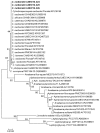Isolation and Characterization of Cylindrospermopsis raciborskii Strains from Finished Drinking Water
- PMID: 31936211
- PMCID: PMC7020411
- DOI: 10.3390/toxins12010040
Isolation and Characterization of Cylindrospermopsis raciborskii Strains from Finished Drinking Water
Abstract
In the summer of 2015, an intense cyanobacterial bloom producing geosmin/2-methylisoborneol (MIB) occurred in the Roxo freshwater reservoir in Alentejo, Portugal. The drinking water supplied from the Roxo water treatment plant (WTP) exhibited an unpleasant odor/taste and a significant cyanobacteria density was detected in the finished water at the exit of the WTP. Cyanobacteria were not evaluated downstream of the WTP, namely, at the city reservoir. The aim of this work was to isolate and characterize viable cyanobacteria present in finished water (exit of the WTP and city reservoir) that withstand conventional water treatment. Treated water samples collected at both sites were inoculated in Z8 culture medium to provide the conditions for putative cyanobacterial growth. After 30 days, filamentous cyanobacteria were observed in cultures inoculated with samples from the exit point of the WTP. Viable trichomes were isolated and identified as Cylindrospermopsis raciborskii by morphometric and molecular analysis. None of the isolates were cylindrospermopsin/microcystin producers, as confirmed by ELISA and amplification of corresponding genes (PS/PKS and mcyA-cd/mcyAB/mcyB). ELISA results were positive for saxitoxin, but saxitoxin and derivatives were not detected by liquid chromatography with fluorescence detection (LC-FLD), nor were their related genes (sxtA/sxtA4/sxtB/sxtM/sxtPer/sxtI). To our knowledge, this is the first report on the establishment of cultures of C. raciborskii that resisted water treatment processes.
Keywords: Cylindrospermopsis raciborskii; culture collection; finished water; saxitoxin.
Conflict of interest statement
The authors declare no conflict of interest.
Figures



Similar articles
-
Cylindrospermopsin and saxitoxin synthetase genes in Cylindrospermopsis raciborskii strains from Brazilian freshwater.PLoS One. 2013 Aug 28;8(8):e74238. doi: 10.1371/journal.pone.0074238. eCollection 2013. PLoS One. 2013. PMID: 24015317 Free PMC article.
-
Genetic variability of the invasive cyanobacteria Cylindrospermopsis raciborskii from Bir M'cherga reservoir (Tunisia).Arch Microbiol. 2011 Aug;193(8):595-604. doi: 10.1007/s00203-011-0704-y. Epub 2011 Apr 10. Arch Microbiol. 2011. PMID: 21479808
-
Cyanobacterial biodiversity of semiarid public drinking water supply reservoirs assessed via next-generation DNA sequencing technology.J Microbiol. 2019 Jun;57(6):450-460. doi: 10.1007/s12275-019-8349-7. Epub 2019 May 27. J Microbiol. 2019. PMID: 31012060
-
Understanding the winning strategies used by the bloom-forming cyanobacterium Cylindrospermopsis raciborskii.Harmful Algae. 2016 Apr;54:44-53. doi: 10.1016/j.hal.2015.10.012. Harmful Algae. 2016. PMID: 28073481 Review.
-
State of knowledge and concerns on cyanobacterial blooms and cyanotoxins.Environ Int. 2013 Sep;59:303-27. doi: 10.1016/j.envint.2013.06.013. Epub 2013 Jul 24. Environ Int. 2013. PMID: 23892224 Review.
Cited by
-
Rapid Changes in the Phytoplankton Community of a Subtropical, Shallow, Hypereutrophic Lake During the Rainy Season.Front Microbiol. 2021 Mar 9;12:617151. doi: 10.3389/fmicb.2021.617151. eCollection 2021. Front Microbiol. 2021. PMID: 33767675 Free PMC article.
-
Structures, Occurrences and Biosynthesis of 11,12,13-Tri-nor-Sesquiterpenes, an Intriguing Class of Bioactive Metabolites.Plants (Basel). 2022 Mar 14;11(6):769. doi: 10.3390/plants11060769. Plants (Basel). 2022. PMID: 35336651 Free PMC article. Review.
References
-
- Nunes L.J.R., Meireles C.I.R., Pinto Gomes C.J., Almeida Ribeiro N.M.C. The Evolution of Climate Changes in Portugal: Determination of Trend Series and Its Impact on Forest Development. Climate. 2019;7:78. doi: 10.3390/cli7060078. - DOI
-
- Carvalho A., Schmidt L., Santos F.D., Delicado A. Climate change research and policy in Portugal: Climate change research and policy in Portugal. Wiley Interdiscip. Rev. Clim. Chang. 2014;5:199–217. doi: 10.1002/wcc.258. - DOI
-
- Ramos S. Master’s Thesis. Faculty of Pharmacy of the University of Lisbon; Lisbon, Portugal: 2017. Previsão da Ocorrência de Blooms de Cianobactérias na Albufeira do Roxo.
-
- Gurung R.P. Master Thesis. International Institute for Geo-Information Science and Earth Observation; Enschede, The Netherlands: 2007. Modelling of Eutrophication in Roxo Reservoir, Alentejo, Portugal—A System Dynamic Based Approach.
Publication types
MeSH terms
Substances
Supplementary concepts
LinkOut - more resources
Full Text Sources
Medical
Miscellaneous

